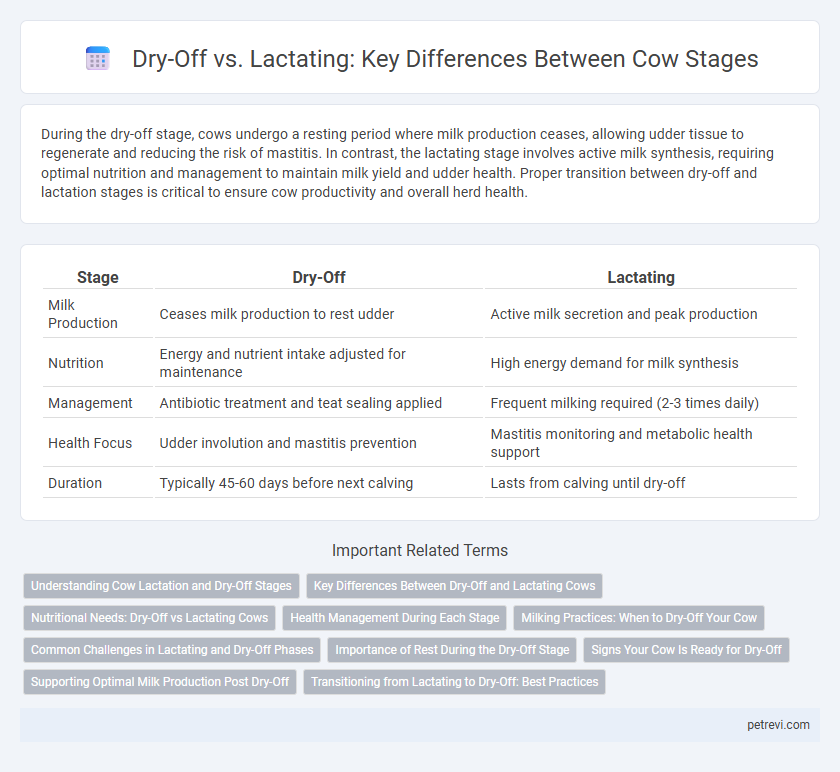During the dry-off stage, cows undergo a resting period where milk production ceases, allowing udder tissue to regenerate and reducing the risk of mastitis. In contrast, the lactating stage involves active milk synthesis, requiring optimal nutrition and management to maintain milk yield and udder health. Proper transition between dry-off and lactation stages is critical to ensure cow productivity and overall herd health.
Table of Comparison
| Stage | Dry-Off | Lactating |
|---|---|---|
| Milk Production | Ceases milk production to rest udder | Active milk secretion and peak production |
| Nutrition | Energy and nutrient intake adjusted for maintenance | High energy demand for milk synthesis |
| Management | Antibiotic treatment and teat sealing applied | Frequent milking required (2-3 times daily) |
| Health Focus | Udder involution and mastitis prevention | Mastitis monitoring and metabolic health support |
| Duration | Typically 45-60 days before next calving | Lasts from calving until dry-off |
Understanding Cow Lactation and Dry-Off Stages
The lactation stage in cows is critical for milk production, typically lasting around 305 days, during which nutrient intake and herd management directly influence yield and udder health. The dry-off stage, usually lasting 45 to 60 days before calving, allows the udder to rest and regenerate, enhancing the subsequent lactation cycle's productivity and reducing mastitis risk. Proper management during both stages ensures optimal milk quality, cow comfort, and overall dairy herd profitability.
Key Differences Between Dry-Off and Lactating Cows
Dry-off cows undergo a non-lactating period allowing udder tissue repair and regeneration, while lactating cows are actively producing milk essential for calf nourishment. During dry-off, energy intake is adjusted to prevent metabolic disorders, whereas lactating cows require higher nutritional support to sustain milk yield. Immune function is enhanced in dry-off cows to reduce mastitis risk, contrasting with the increased metabolic stress experienced by lactating cows.
Nutritional Needs: Dry-Off vs Lactating Cows
Dry-off cows require a diet lower in energy and protein to prevent metabolic disorders and promote udder tissue repair, emphasizing high-fiber forages to maintain rumen health. Lactating cows need increased energy, protein, and minerals, such as calcium and phosphorus, to support milk production and meet elevated metabolic demands. Balancing nutrient intake during these stages is critical for optimizing productivity and overall dairy herd health.
Health Management During Each Stage
Health management during the dry-off stage centers on reducing infection risk and preparing the mammary gland for the next lactation by ensuring proper udder hygiene, administering dry cow therapy, and maintaining optimal nutrition to support immune function. In the lactating stage, emphasis is placed on monitoring milk production, preventing mastitis through regular udder checks, and maintaining a balanced diet rich in energy, protein, and minerals to sustain cow health and milk quality. Effective management in both stages minimizes metabolic disorders and promotes overall productivity throughout the cow's lactation cycle.
Milking Practices: When to Dry-Off Your Cow
Dry-off in cows marks the end of lactation, typically occurring 60 days before calving to allow udder tissue regeneration and maximize future milk yield. Milking practices during lactation focus on consistent milking intervals and proper machine settings to prevent mastitis and optimize milk production. Proper timing of dry-off balances milk production decline with udder health, ensuring cow comfort and high-quality milk in the subsequent lactation.
Common Challenges in Lactating and Dry-Off Phases
Lactating cows commonly face challenges such as mastitis, decreased feed intake, and metabolic stress due to high milk production demands. During the dry-off phase, cows are susceptible to udder infections and stress from sudden dietary changes, requiring careful management to ensure udder health and optimal milk yield in the next lactation cycle. Effective transition strategies between these stages, including proper nutrition and hygiene, are critical to minimizing health risks and maintaining productivity.
Importance of Rest During the Dry-Off Stage
Rest during the dry-off stage is crucial for cows to regenerate udder tissue and boost immune function, which enhances milk production in the next lactation cycle. Proper dry-off management reduces the risk of mastitis and supports overall cow health, leading to higher milk yield and quality. Ensuring adequate rest helps transition cows smoothly from lactation to dry period, optimizing reproductive performance and longevity.
Signs Your Cow Is Ready for Dry-Off
Signs your cow is ready for dry-off include a noticeable decrease in milk production, reduced udder fill, and a less frequent nursing pattern. Behavioral changes such as increased restlessness and seeking more comfort can also indicate the approaching dry period. Monitoring these physiological and behavioral cues ensures optimal timing for dry-off, promoting udder health and improved milk quality during subsequent lactation stages.
Supporting Optimal Milk Production Post Dry-Off
Proper management during the dry-off stage is essential to support optimal milk production in the subsequent lactating period. Ensuring adequate nutrition, maintaining udder health, and implementing effective resting protocols during dry-off enhances mammary tissue regeneration and reduces infection risks, directly influencing milk yield and quality. Strategic dry-off practices promote a smooth transition into lactation, maximizing productivity and overall herd performance.
Transitioning from Lactating to Dry-Off: Best Practices
Effective transition from lactating to dry-off in cows requires gradual reduction in milk production and proper dry cow therapy to prevent mastitis and promote udder health. Implementing a consistent dry-off schedule and providing balanced nutrition supports optimal recovery and prepares cows for the next lactation cycle. Monitoring body condition score and minimizing stress during this period enhances immune function and overall productivity.
Dry-Off vs Lactating for Cow Stage Infographic

 petrevi.com
petrevi.com